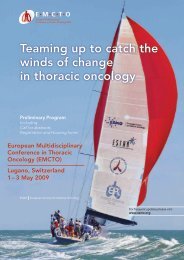Bladder cancer - European Society for Medical Oncology
Bladder cancer - European Society for Medical Oncology
Bladder cancer - European Society for Medical Oncology
You also want an ePaper? Increase the reach of your titles
YUMPU automatically turns print PDFs into web optimized ePapers that Google loves.
Radical cystectomy* leads to the loss of bladder function, that is, the storage of urine. The<br />
surgeon will there<strong>for</strong>e connect the ureters* to a new outlet to allow evacuation of urine (called a<br />
urinary diversion*). This new outlet may be either the urethra*, the skin of the abdomen, or the<br />
very last part of the large bowel (called a rectosigmoid diversion). The choice of approach<br />
depends on many factors such as the tumor stage, the structures that can be preserved after<br />
radical cystectomy, the patient’s general medical condition and the patient’s preference. The<br />
different options are explained further in the text (see Side effects* of therapies).<br />
In addition, radical cystectomy may involve the removal of certain reproductive organs*. This may<br />
lead to sexual dysfunction* and/or the loss of reproductive function* (see Side effects of<br />
Therapies).<br />
Chemotherapy*<br />
For patients with stage T2 or T3 disease it is recommended to give neo‐adjuvant combination<br />
chemotherapy. This means that a combination of chemotherapeutic* drugs is given prior to<br />
cystectomy* or definitive radiotherapy*. The recommended combinations are gemcitabine* and<br />
cisplatin* (abbreviated GC), or methotrexate*, vinblastine*, doxorubicin* and cisplatin<br />
(abbreviated MVAC). The purpose of neo‐adjuvant therapy* is to eradicate micrometastases*,<br />
reduce tumor size and reduce the risk that tumor cells spread during the surgical procedure.<br />
Radiotherapy*<br />
Radiotherapy alone may be indicated <strong>for</strong> patients who are medically not fit to<br />
undergo the extensive surgery of radical cystectomy*.<br />
In selected cases where the treatment aims to preserve the bladder,<br />
radiotherapy may be given as part of a combination treatment* (see: organ<br />
preservation therapy*).<br />
Organ preservation therapy*<br />
Organ preservation therapy refers to a treatment where the bladder is<br />
preserved. This is proposed <strong>for</strong> patients who do not wish to undergo radical<br />
cystectomy*, or who are medically not fit to tolerate this kind of surgery. This treatment can be:<br />
aggressive TURB*, TURB in combination with radiotherapy* or chemotherapy*, or TURB in<br />
combination with radio‐ ánd chemotherapy. The latter is called trimodality combination<br />
treatment and is the preferred approach.<br />
Organ preservation therapy may also be considered in selected patients with early stage bladder<br />
<strong>cancer</strong>, provided they meet a number of other stringent medical criteria.<br />
Organ preservation therapy requires a stringent lifelong follow‐up* with cystoscopy* and urine<br />
cytology* to evaluate the response to treatment and to detect disease recurrence. If persistent or<br />
recurrent disease is observed, an immediate cystectomy is recommended, if possible.<br />
Treatment plan <strong>for</strong> advanced and metastatic* disease (stage IV)<br />
At this stage, the tumor has grown through the bladder wall into the wall of the pelvis or the<br />
abdomen, or beyond the abdomen to distant organs. Since it is difficult or not medically indicated to<br />
remove all tumor by surgery, the primary goal of the treatment is to target tumor cells using<br />
chemotherapy that is given through a vein and that there<strong>for</strong>e acts systemically.<br />
<strong>Bladder</strong> <strong>cancer</strong>: a guide <strong>for</strong> patients‐ In<strong>for</strong>mation based on ESMO Clinical Practice Guidelines ‐v.2012.1 Page 14<br />
This document is provided by Reliable Cancer Therapies with the permission of ESMO.<br />
The in<strong>for</strong>mation in this document does not replace a medical consultation. It is <strong>for</strong> personal use only and cannot be modified,<br />
reproduced or disseminated in any way without written permission from ESMO and Reliable Cancer Therapies.
















